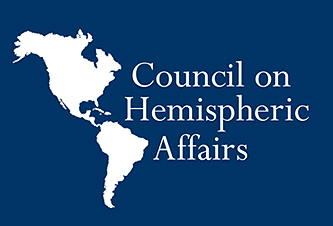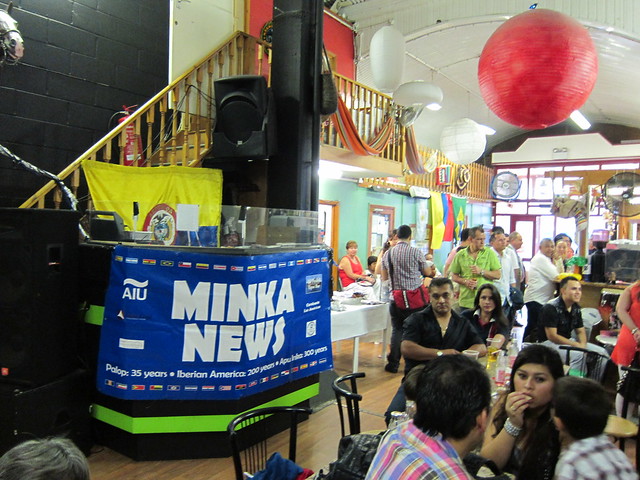 |  |  |
| |
INDEX THE NOTTING HILL CARNIVAL AND ITS SOUTH AMERICAN ROOTS ECUADORIAN PICNIC BRAZILIAN FILM FESTIVAL AND OTHER EVENTS IN THE UK COLOMBIAN SHIP IN LONDON LIBYA: A PREMATURE VICTORY CELEBRATION. By Strafor Analysis of political events in Chile, Haiti and Brazil by COHA
NOTTING HILL CARNIVAL AND ITS SOUTH AMERICAN ROOTS More than one million people attended Notting Hill between Sunday and Monday to participate in the largest South American carnival outside South America.
The Latin and Iberian American roots of Europe’s largest street party are not always acknowledged.
It is said that Notting Hill Carnival was inspired by the Trinidad and Tobago ones. Trinidad is a South American island separated from Venezuela only by around ten miles of the small Gulf of Paria. There are other 5 larger islands very close to the South American coast: Isla Grande de Tierra del Fuego (Chile and Argentina), Marajó (Brazil), Chiloé, Wellington and Riesco (Chile).
Trinidad, like most of the Caribbean, was settled by Amerindians that originally came from the Amazon and the Orinoco basins. In 1498 Columbus arrived in Trinidad and Tobago when most of his inhabitants spoke an Arawak tongue, a family of languages spread from Florida to Argentina which also included the royal Inca language: Puquina.
Trinidad and Tobago is the world’s only republic that its two names and of its capital are Hispanics. Trinidad and Tobago derivates from the Spanish/Portuguese words of Trinity and Tobacco and its capital Port of Spain remains a clear reference of its original colonizers. The former Hispaniola, New Spain, New Castile or New Grenada were re-baptised as Dominican/Haitian republics, Mexico, Peru and Colombia. Port of Spain is the only capital in the former Spanish/Portuguese speaking world that still have the name of its former Empire (Spain).
Trinidad and Tobago where under Spanish control until Sir Ralph Abercromby invaded and took the Island of Trinidad from Spanish Governor, Don José Maria Chacón, with 10,000 British troops in 1797. In 1802 it was officially ceded to the UK, albeit it was ruled by Spanish law.
Trinidad was separated from Spain just before the Latin American independence movement achieved its first victory in the Dominican island in 1804. Bolívar later on accepted the British rule in Trinidad and in the Antilles because the UK was its greatest allied against Spain.
The British reshaped Trinidad’s population. In the census of 1777 2000 of its 2763 inhabitants were Arawak Indians, but then big waves of Africans and later on Asians arrived there.
The Trinidad carnival like other famous South Americans carnivals (like Barranquilla, Oruro or Río) celebrates a Catholic date of the year and it shows the influence of their original Latin European masters (Spain, Brazil or France) mixed with the rhythms of its former African slaves or Amerindian serfs.
Britain classified its former and current colonies in Middle America as Caribbean. However, it’s larger one (Guyana) is inside the South American continent and it doesn’t have any Caribbean coast. Jamaica and all the Antilles originally had the same Arawak/Caribe native populations as the rest of South America’s north Atlantic coast and inner core. Until 2, 3 or 4 centuries ago all of them started to have ‘modern’ and Christian states under Spanish rule.
In December 2011 in Margarita (after Trinidad the second largest island above Venezuela’s mainland) all the 33 South and Central American states (including all the independent Caribbean countries) are going to adopt the official name and structure of the Community of States of Latin American and the Caribbean.
Already the Notting Hill Carnival has also a strong Brazilian Samba and Salsa components. In the near future we hope that many Latin American bands would integrate the carnival of London, Europe’s largest Latin American and Caribbean city.
PARAISO SCHOOL OF SAMBA, ONE OF THE CONSTANT ATTRACTIONS IN EVERY NOTTING HILL CARNIVAL
ECUADORIAN COMMUNITY ASSOCIATION'S PICNIC During the Carnival the Ecuadorian Community Association (ECA) organised a series of sports and cultural activities at Finsbury Park. IN THE FOOTBALL CUP THE LATINOS UNIDOS TEAM WON. BELOW: LUIS REINOSO (PRESIDENT OF THE ECUADORIAN COMMUNITY ASSOCIATION) GAVE THE TROPHY TO HUGO QUITO (LATINOS UNIDOS COACH) LUIS REINOSO, ECA'S PRESIDENT, PHONED MINKA TO EXPRESS HIS GRATITUDE TO AROUND 300 PEOPLE THAT ATTENDED THE PICNIC WHICH UNITED THE ECUADORIAN COMMUNITY.
THIS YEAR THERE WAS NOT CARNAVAL DEL PUEBLO BUT A CARNAVALITO DEL PUEBLO WAS ORGANISED IN THE SAME STREET IN ELEPHANT AND CASTLE AS EVERY YEAR THIS LATIN CARNIVAL USED TO START. DISTRIANDINA (IN THE PICTURE) WAS THE ORGANISER.
COLOMBIAN NAVY’S SHIP ARC GLORIA PASSED THROUGH TOWER BRIDGE
The ARC Gloria, one of the biggest tall ships in the world, still in service, passed through Tower Bridge after a successful three-day visit to London. It is almost 20 years since the Colombian Navy's ship Gloria last sailed into London, this time on a goodwill tour of the world, received over 7.000 visitors during its time in the city. (see pictures) The ship, with its massive flag unfurled and the 81 cadets on the masts singing the Ship’s anthem (See video) passed through Tower Bridge on Friday 26 August 2011 – 12:15 (Up-river) and 12:45 (Down-river) -
Mercedes Osma-Peralta Press Attaché, Embassy of Colombia |
|
| |



| |
|
PRAYS FOR THE DAY OF BRAZIL
Igreja Philapdelphia Sábado 10 de Setembro de 20111, às 7:30 pm. 454 A High Road N17 9JD. High Road, Totenham.
Domingo, 11 de Setembro de 2011, às 11 am. Cathedral of Revival Church . Rear of 42-44 Norwood High Str. SE27 9NR.
Brazilian Events in the UK
Please note that the information below has been provided by venues and artists,
and that the Embassy of Brazil cannot be held responsible for the content of external websites or publications
3rd London Brazilian Film Festival 6 - 10 September 2011 Opening night: BAFTA, 195 Piccadilly, London W1J 9LN Screenings: Odeon Covent Garden, 135 Shaftesbury Avenue, London WC2H 8AH The Inffinito Festival - for the last 15 years the principal overseas showcase for Brazilian cinema - returns to London after successful events this summer in New York and Miami. The 3rd Brazilian Film Festival kicks off at BAFTA's headquarters on 6 September with Claudio Torres’ The Man from the Future, then over the following days the Odeon Covent Garden will be showing ten feature films and nine shorts. The programme also includes the Crystal Lens Award Ceremony for Best Feature Film, as chosen by the audiences, and a WFTV tribute to producer Paula Barreto. Contact: 07939 941831 Consuelo Radclyffe - Fables and Figments 18 June - 4 September 2011 | 10am-5.30pm Ruthin Centre Applied Arts, Park Road, Ruthin, Denbigshire LL15 1BB A group exhibition whose roots lie in the deep figurative sculptural traditions of Britain (early metal casting, stone carving, misericords, slipware ceramics); there is a wealth of imagery available. This show explores the work of contemporary figurative ceramicists, revolving around the rich themes of symbol, myth, and folklore. The exhibition includes works by the Brazilian artists Consuelo Radclyffe. I am Braziliality Art Festival & Exhibition29 July - 30 August 2011 Formans' Smokehouse Gallery, Stour Road, Fish Island, Hackney Wick, London E3 2NT I am Braziliality showcases the work of over 40 artists and projects exploring critical aspects and aggregated meanings of the Brazilian cultural roots of artists living around the world. The show is about art from and of the streets, bringing graffiti, illustration, graphic design, photography, video art, sculptures, installations and live art and music performances to Forman's Smoke House Gallery, in Hackney Wick, during the Hackney Wicked Festival. Mystics or Rationalists? 4 August - 22 October 2011 Ingleby Gallery, 15 Calton Road, Edinburgh EH8 8DL It is forty years since Sol LeWitt published his famous Sentences: a sequence of 35 statements that defined personal parameters for the making and understanding of conceptual art. Sentence number one provides the title and inspiration for Ingleby Gallery’s exhibition for the 2011 Edinburgh Art Festival and is still a compelling and instructive introduction to the first principles of conceptual art. The exhibition presents the work of nine artists each of whom make work that invites the viewer to make the leap between an idea and an object, amongst them the celebrated Brazilian artist Iran do Espírito Santo, who will present a series of recent sculptures that dignify the familiarly banal with enormous shifts of scale and material. 'Elite Squad: The Enemy Within' From 12 August 2011 Selected cinemas across the UK The biggest film in South American cinema history, Elite Squad: The Enemy Within sees revered Lieutenant-Colonel Roberto Nascimento and his second incommand André Matias facing battles both on the streets and within the corrupt political system of Rio de Janeiro. Featuring scenes of breathtaking action and compelling drama, José Padilha's critically acclaimed blockbuster is based on a blend of intense research and real events, presenting a devastating vision of modern Rio and one man's fight against the system. 1st Brazilian Corporate Communications Day London 7 September 2011 CIPR Public Relations Centre, 52-53 Russell Square, London The 1st Brazilian Corporate Communications Day is hosted by the Brazilian Association for Business Communications – Aberje and the Chartered Institute of Public Relations – CIPR. This conference will focus on how leading Brazilian organizations are helping to define "Brand Brazil" while using corporate communications and public relations to build brand awareness and public trust in a global marketplace. The first speaker confirmed is Izeusse Braga, Head of International Corporate Communications from Petrobras, an integrated energy company, the 34th largest company in the world, according to Fortune, and the largest in Brazil with a presence in 27 other countries. Luiz Zerbini - Every Jetson has a Flintstone inside 9 September - 1 October 2011 Max Wigram Gallery, 106 New Bond Street, London W1S 1DN Luiz Zerbini creates textured immersive worlds; large-scale, colourful landscapes strewn with lush, exotic vegetation, stormy pixellated seascapes; buildings partially hidden by trees and overhanging branches, domestic interiors, and extensive silvery surfaces dotted with tiny geometric blocks of colour. The shallow interiors of his paintings often seep into the gallery space, connecting to real plants and flowers, and to sculptures resembling human bones or fragments of mosaic paving. Glass vase-sculptures contain succulent green leaves or long bones constructing strange watery layers of changing perception. More compact white, green and orange collages utilise old slide mounts alluding to art history, and the process of making and archiving art. Brazilian Chamber of Commerce: End-of-Summer Cocktail & BBQ 15 September Dartmouth House, London (see link below for full address) In the beautiful surroundings of Dartmouth House the Chamber of Commerce will bring a taste of Brazil to the capital, with live Brazilian MPB, caipirinhas and Brazilian ‘salgadinhos’ on offer, as well as a full outdoor BBQ to accommodate 100 of our guests and members. Members £30; non-members £45. (+55)Brazil 15 September - 20 November 2011 The Gallery @ The Civic, Hanson Street, Barnsley S70 2HZ The Gallery@ The Civic is proud to announce a fantastic new exhibition celebrating the best of contemporary Brazilian craft and design, and investigating the influences that established the sector as it is today: (+55)Brazil opens from 15th September. Featured designers include celebrated architect Paulo Mendes da Rocha, Brazil's most well known furniture designers the Campana brothers, internationally respected fashion designer Jum Nakao, design houses OVO, Fetiche Design and Faro Design, up and coming design stars Rodrigo Almeida and Sérgio J. Matos, as well as much loved brands Melissa and Havaianas, amongst many others. London Classical Guitar Festival: ‘Fantasia Brasileira’ with Celso Machado Solo concert, 16 September, 7.30pm; Masterclasses (tbc), 17 September, 3pm; ‘Gala’ concert, 17 September, 7.30pm Bolivar Hall, 54, Grafton Way, London, W1T 5DL Brazilian-born guitarist/singer/percussionist Celso Machado makes a rare UK appearance to delight audiences with his mixture of infectious vocals, irresistible rhythm and inspired lunacy. Hailed as the most important Brazilian guitarist of the new generation, Machado ‘finds an orchestra-full of ways to use his voice and makes percussion instruments of his entire body: cheeks, mouth, chest, hands, and legs — not to mention the various parts of the microphone stand’ (The Detroit News). Admission free; no booking required. Brazil in Tune 18 September 2011 Proud Camden, Stables Market, Chalk Farm Road, London NW1 8AH Brazil in Tune is a fresh night presented by Fernanda Rabelo and Creative Brazil which intends to show great Brazilian musicians and their recent work. Amazingly its first edition brings a line up filled with experts. Dani Turcheto is coming from Sao Paulo to tour Europe specially presenting 'Madeira Torta', his second album released this year. Gui Tavares has been successfully performing in the UK since his first concert with Bosco de Oliveira in 2000 at Barbican, a night when Bossa Nova legend Joao Gilberto went on the same stage. The Peripatetic School: Itinerant drawing from Latin America 22 September - 13 November 2011 Drawing Room, Tannery Arts, Brunswick Wharf, 55 Laburnum Street, London E2 8BD An exhibition of works by artists from across Latin America, including the Brazilians André Komatsu and Brígida Baltar, who share an engagement with the landscape, whether urban or rural. More specifically, they are concerned with travelling or moving through the landscape, and frequently with walking, which is combined in their work with diverse approaches to drawing. The exhibition, curated by Tanya Barson, Curator of International Art, Tate Modern, is supported by the Brazilian Ministry of External Relations. 1st European Conference for Brazilian Postgraduate Students and Researchers - ABEP 14 - 15 October 2011 King's College London, Strand, London WC2R 2LS The Brazilian Association of Post-graduate Students and Researchers in the United Kingdom (ABEP) invites applications from Brazilian students (master and PhD levels) and researchers to present papers or posters on the Conference. "1st European Conference for Brazilian Postgraduate Students and Re-searchers". Whilst primarily aimed at Brazilian post-graduate students and researchers, the Conference is open to everyone working with or interested in Brazil. For the most part, it will be in Portuguese. Please contact ABEP directly for more information. Lost in Lace 29 October 2011 - 19 February 2012 Birmingham Museum and Art Gallery, Chamberlain Square, Birmingham B3 3DH An ambitious exhibition featuring large-scale, theatrical and visually stimulating work by international artists who have been inspired by the language of lace. 'Lost in Lace' will entice visitors into magical environments where spaces become fluid and thread creates new boundaries. Visitors will be able to walk through, between, and under textile installations in the architectural spaces. Striking attention to detail and the symbolic language, patterns and techniques of lace will show visitors the radical new approaches to textile and space being made by UK and international artists. Featured artists showcasing their work include Lise Bjørne Linnert, Michael Brennand-Wood, Tamar Frank. The exhibition will feature a large-scale installation by Brazilian artist Ana Holck and is supported by the Brazilian Ministry of External Relations. The Peripatetic School: Itinerant drawing from Latin America 24 November 2011 - 4 March 2012 Mima, Middlesbrough Institute of Modern Art, Centre Square, Middlesbrough TS1 2AZ An exhibition of works by artists from across Latin America, including the Brazilians André Komatsu and Brígida Baltar, who share an engagement with the landscape, whether urban or rural. More specifically, they are concerned with travelling or moving through the landscape, and frequently with walking, which is combined in their work with diverse approaches to drawing. The exhibition, curated by Tanya Barson, Curator of International Art, Tate Modern, is supported by the Brazilian Ministry of External Relations. Libya: A Premature Victory CelebrationBy George Friedman (Stratfor) The war in Libya is over. More precisely, governments and media have decided that the war is over, despite the fact that fighting continues. The unfulfilled expectation of this war has consistently been that Moammar Gadhafi would capitulate when faced with the forces arrayed against him, and that his own forces would abandon him as soon as they saw that the war was lost. What was being celebrated last week, with presidents, prime ministers and the media proclaiming the defeat of Gadhafi, will likely be true in due course. The fact that it is not yet true does not detract from the self-congratulations. For example, Italian Foreign Minister Franco Frattini reported that only 5 percent of Libya is still under Gadhafi’s control. That seems like a trivial amount, save for this news from Italian newspaper La Stampa, which reported that “Tripoli is being cleaned up” neighborhood by neighborhood, street by street and home by home. Meanwhile, bombs from above are pounding Sirte, where, according to the French, Gadhafi has managed to arrive, although it is not known how. The strategically important town of Bali Walid — another possible hiding place and one of only two remaining exit routes to another Gadhafi stronghold in Sabha — is being encircled. To put it differently, Gadhafi’s forces still retain military control of substantial areas. There is house-to-house fighting going on in Tripoli. There are multiple strongholds with sufficient defensive strength that forces cannot enter them without significant military preparation. Although Gadhafi’s actual location is unknown, his capture is the object of substantial military preparations, including NATO airstrikes, around Bali Walid, Sirte and Sabha. When Saddam Hussein was captured, he was hiding in a hole in the ground, alone and without an army. Gadhafi is still fighting and posing challenges. The war is not over. It could be argued that while Gadhafi retains a coherent military force and significant territory, he no longer governs Libya. That is certainly true and significant, but it will become more significant when his enemies do take control of the levers of power. It is unreasonable to expect that they should be in a position to do so a few days after entering Tripoli and while fighting continues. But it does raise a critical question: whether the rebels have sufficient coherence to form an effective government or whether new rounds of fighting among Libyans can be expected even after Gadhafi’s forces cease functioning. To put it simply, Gadhafi appears to be on his way to defeat but he is not there yet, and the ability of his enemies to govern Libya is doubtful. Immaculate InterventionGiven that the dying is far from over, it is interesting to consider why Barack Obama, Nicolas Sarkozy and David Cameron, the major players in this war, all declared last week that Gadhafi had fallen, implying an end to war, and why the media proclaimed the war’s end. To understand this, it is important to understand how surprising the course of the war was to these leaders. From the beginning, there was an expectation that NATO intervention, first with a no-fly zone, then with direct airstrikes on Gadhafi’s position, would lead to a rapid collapse of his government and its replacement with a democratic coalition in the east. Two forces combined to lead to this conclusion. The first consisted of human-rights groups outside governments and factions in foreign ministries and the State Department who felt an intervention was necessary to stop the pending slaughter in Benghazi. This faction had a serious problem. The most effective way to quickly end a brutal regime was military intervention. However, having condemned the American invasion of Iraq, which was designed, at least in part, to get rid of a brutal regime, this faction found it difficult to justify rapid military intervention on the ground in Libya. Moral arguments require a degree of consistency. In Europe, the doctrine of “soft power” has become a central doctrine. In the case of Libya, finding a path to soft power was difficult. Sanctions and lectures would probably not stop Gadhafi, but military action ran counter to soft power. What emerged was a doctrine of soft military power. Instituting a no-fly zone was a way to engage in military action without actually hurting anyone, except those Libyan pilots who took off. It satisfied the need to distinguish Libya from Iraq by not invading and occupying Libya but still putting crushing pressure on Gadhafi. Of course, a no-fly zone proved ineffective and irrelevant, and the French began bombing Gadhafi’s forces the same day. Libyans on the ground were dying, but not British, French or American soldiers. While the no-fly zone was officially announced, this segue to an air campaign sort of emerged over time without a clear decision point. For human-rights activists, this kept them from addressing the concern that airstrikes always cause unintended deaths because they are never as accurate as one might like. For the governments, it allowed them to be seen as embarking upon what I have called an “ immaculate intervention.” The second force that liked this strategy was the various air forces involved. There is no question of the importance of air power in modern war, but there is a constant argument over whether the application of air power by itself can achieve desired political ends without the commitment of ground forces. For the air community, Libya was going to be the place where it could demonstrate its effectiveness in achieving such ends. So the human-rights advocates could focus on the ends — protecting Libyan civilians in Benghazi — and pretend that they had not just advocated the commencement of a war that would itself leave many people dead. Political leaders could feel that they were not getting into a quagmire but simply undertaking a clean intervention. The air forces could demonstrate their utility in delivering desired political outcomes. Why and HowThe question of the underlying reason for the war should be addressed because stories are circulating that oil companies are competing for vast sums of money in Libya. These stories are all reasonable, in the sense that the real story remains difficult to fathom, and I sympathize with those who are trying to find a deep conspiracy to explain all of this. I would like to find one, too. The problem is that going to war for oil in Libya was unnecessary. Gadhafi loved selling oil, and if the governments involved told him quietly that they were going to blow him up if he didn’t make different arrangements on who got the oil revenues and what royalties he got to keep, Gadhafi would have made those arrangements. He was as cynical as they come, and he understood the subtle idea that shifting oil partners and giving up a lot of revenue was better than being blown up. Indeed, there is no theory out there that explains this war by way of oil, simply because it was not necessary to actually to go war to get whatever concessions were wanted. So the story — protecting people in Benghazi from slaughter — is the only rational explanation for what followed, however hard it is to believe. It must also be understood that given the nature of modern air warfare, NATO forces in small numbers had to be inserted on the ground from the beginning — actually, at least a few days before the beginning of the air campaign. Accurately identifying targets and taking them out with sufficient precision involves highly skilled special-operations teams guiding munitions to those targets. The fact that there have been relatively few friendly-fire accidents indicates that standard operational procedures have been in place. These teams were probably joined by other special operators who trained — and in most cases informally led — indigenous forces in battle. There were ample reports in the early days of the war that special operations teams were on the ground conducting weapons training and organizing the fighters who opposed Gadhafi. But there proved to be two problems with this approach. First, Gadhafi did not fold his tent and capitulate. He seemed singularly unimpressed by the force he was facing. Second, his troops turned out to be highly motivated and capable, at least compared to their opponents. Proof of this can be found in the fact that they did not surrender en masse, they did maintain a sufficient degree of unit coherence and — the final proof — they held out for six months and are still holding out. The view of human-rights groups that an isolated tyrant would break in the face of the international community, the view of political leaders that an isolated tyrant facing the might of NATO’s air forces would collapse in days and the view of the air forces that air strikes would shatter resistance, all turned out to be false. A War ProlongedPart of this was due to a misunderstanding of the nature of Libyan politics. Gadhafi was a tyrant, but he was not completely isolated. He had enemies but he also had many supporters who benefitted from him or at least believed in his doctrines. There was also a general belief among ordinary government soldiers (some of whom are mercenaries from the south) that capitulation would lead to their slaughter, and the belief among government leaders that surrender meant trials in The Hague and terms in prison. The belief of the human-rights community in an International Criminal Court (ICC) trying Gadhafi and the men around him gives them no room for retreat, and men without room for retreat fight hard and to the end. There was no way to negotiate capitulation unless the U.N. Security Council itself publicly approved the deal. The winks and nods that got dictators to leave in the old days aren’t enough anymore. All countries that are party to the Rome Statute are required to turn a leader like Gadhafi over to the ICC for trial. Therefore, unless the U.N. Security Council publicly strikes a deal with Gadhafi, which would be opposed by the human-rights community and would become ugly, Gadhafi will not give up — and neither will his troops. There were reports last week that some government soldiers had been executed. True or not, fair or not, that would not be a great motivator for surrender. The war began with the public mission of protecting the people of Benghazi. This quickly morphed into a war to unseat Gadhafi. The problem was that between the ideological and the military aims, the forces dedicated to the war were insufficient to execute the mission. We do not know how many people were killed in the fighting in the past six months, but pursuing the war using soft military power in this way certainly prolonged the war and likely caused many deaths, both military and civilian. After six months, NATO got tired, and we wound up with the assault on Tripoli. The assault appears to have consisted of three parts. The first was the insertion of NATO special operations troops (in the low hundreds, not thousands) who, guided by intelligence operatives in Tripoli, attacked and destabilized the government forces in the city. The second part was an information operation in which NATO made it appear that the battle was over. The bizarre incident in which Gadhafi’s son, Seif al-Islam, announced as being captured only to show up in an SUV looking very un-captured, was part of this game. NATO wanted it to appear that the leadership had been reduced and Gadhafi’s forces broken to convince those same forces to capitulate. Seif al-Islam’s appearance was designed to signal his troops that the war was still on. Following the special operations strikes and the information operations, western rebels entered the city to great fanfare, including celebratory gunfire into the air. The world’s media chronicled the end of the war as the special operations teams melted away and the victorious rebels took the bows. It had taken six months, but it was over. And then it became obvious that it wasn’t over. Five percent of Libya — an interesting calculation — was not liberated. Street fighting in Tripoli continued. Areas of the country were still under Gadhafi’s control. And Gadhafi himself was not where his enemies wanted him to be. The war went on. A number of lessons emerge from all this. First, it is important to remember that Libya in itself may not be important to the world, but it matters to Libyans a great deal. Second, do not assume that tyrants lack support. Gadhafi didn’t govern Libya for 42 years without support. Third, do not assume that the amount of force you are prepared to provide is the amount of force needed. Fourth, eliminating the option of a negotiated end to the war by the means of international courts may be morally satisfying, but it causes wars to go on and casualties to mount. It is important to decide what is more important — to alleviate the suffering of people or to punish the guilty. Sometimes it is one or the other. Fifth, and most important, do not kid the world about wars being over. After George W. Bush flew onto an aircraft carrier that was emblazoned with a “mission accomplished” banner, the Iraq war became even more violent, and the damage to him was massive. Information operations may be useful in persuading opposing troops to surrender, but political credibility bleeds away when the war is declared over and the fighting goes on. Gadhafi will likely fall in the end. NATO is more powerful than he is, and enough force will be brought to bear to bring him down. The question, of course, is whether there was another way to accomplish that with less cost and more yield. Leaving aside the war-for-oil theory, if the goal was to protect Benghazi and bring down Gadhafi, greater force or a negotiated exit with guarantees against trials in The Hague would likely have worked faster with less loss of life than the application of soft military power.  |
August 24, 2011 This analysis was prepared by COHA Research Associate PoLin So
- Education reform at primary, secondary, and university levels in Chile is a longstanding social and political issue that has now forced President Sebastián Piñera to reassess the country’s antiquated and class-ridden education system to meet the expectations of students.
- In a collective effort aimed at widespread reform, protesters have demanded greater transparency and state control, and above all, have insisted upon quality education without high university tuition costs.
- While the Piñera administration’s attempts to pacify protesters have led to further social unrest, the nation and its students await an acceptable agreement to be reached.
Continue at August 30, 2011 This analysis was prepared by Research Associate Elizabeth Rust Amidst a painstakingly difficult recovery from the January 2010 earthquake, Haiti still struggles to forge a definitive path toward true economic stability and an acceptable standard of living for its citizens. Much attention has been devoted to Haiti’s underlying structural difficulties; specifically, analysts harp on the notion that Haiti is a “failed state” and lacks strong political institutions. At this moment, however, it is worth identifying the ways in which Haiti’s problems are attributable to individual people—namely, Haitian politicians. Haiti’s New President: Struggling ‘Sweet Micky’ Seven months after its November 2010 presidential election, Haiti still lacks a complete administration. Following a messy and drawn-out campaign that included accusations of election fraud and international intervention on the part of the OAS and Western nations, Michel “Sweet Micky” Martelly finally emerged as Haiti’s next president. [i] Martelly took office on May 14, 2011, and his few months in office have thus far revealed little about the shape his presidency might take. Still, his inability to implement meaningful policy up to now can be attributed to his failure to choose an acceptable candidate for prime minister, his second-in-command. Martelly attempted to put together a new government quickly: two days before he took office, he nominated neoliberal businessman Daniel Gérard Rouzier as prime minister. [ii] But after a month of wrangling in Parliament, Rouzier was rejected by the legislature on June 21, 2011. Just a couple of weeks later, Martelly found an alternative, former Minister of Justice Bernard Gousse. Gousse’s confirmation was even more unlikely; he too was rejected by the legislature on August 2, 2011. Thus, it may be months before Haiti assembles a basic government. August 29, 2011 This analysis was prepared by COHA Research Fellow Alex Sanchez Brazil’s leadership in the United Nations Stabilization Mission in Haiti (MINUSTAH) may be coming to its end. The newly-appointed defense minister, Celso Amorin (most recently he served as foreign affairs minister from 2003 to 2011) recently declared to the Brazilian media that he “supports the withdrawal of Brazilian troops from Haiti.” [1] Should this happen, it would be a major departure from the status quo, and would greatly affect MINUSTAH’s operations, as well as jolt Brazil’s role as the Caribbean’s major arbiter of security. Furthermore, Brasilia’s quest for a permanent seat in the United Nations Security Council (UNSC) has been partially based on its role in MINUSTAH as an example of its readiness for a UN seat, which may now be called into question. Brazil’s role in Haiti Brasilia racked up a huge leadership role in MINUSTAH, which had as its mission to aid the transitional government that gained control of Haiti (via the UNSC’s resolution 1542) after President Jean-Bertrand Aristide was ousted in early 2004. The mission was controversial at the time and drew heavy criticism from its inception as it was regarded as a type of colonial government by the UN in the wake of Aristide’s abrupt forced departure from power, following major national protests and violence. At the time, there were persistent accusations that the U.S., Canada and France had a role in the Haitian head of state’s ouster. Bolivian Information Forum Bulletin 20, August-September 2011 Contents .............................
|
































No comments:
Post a Comment